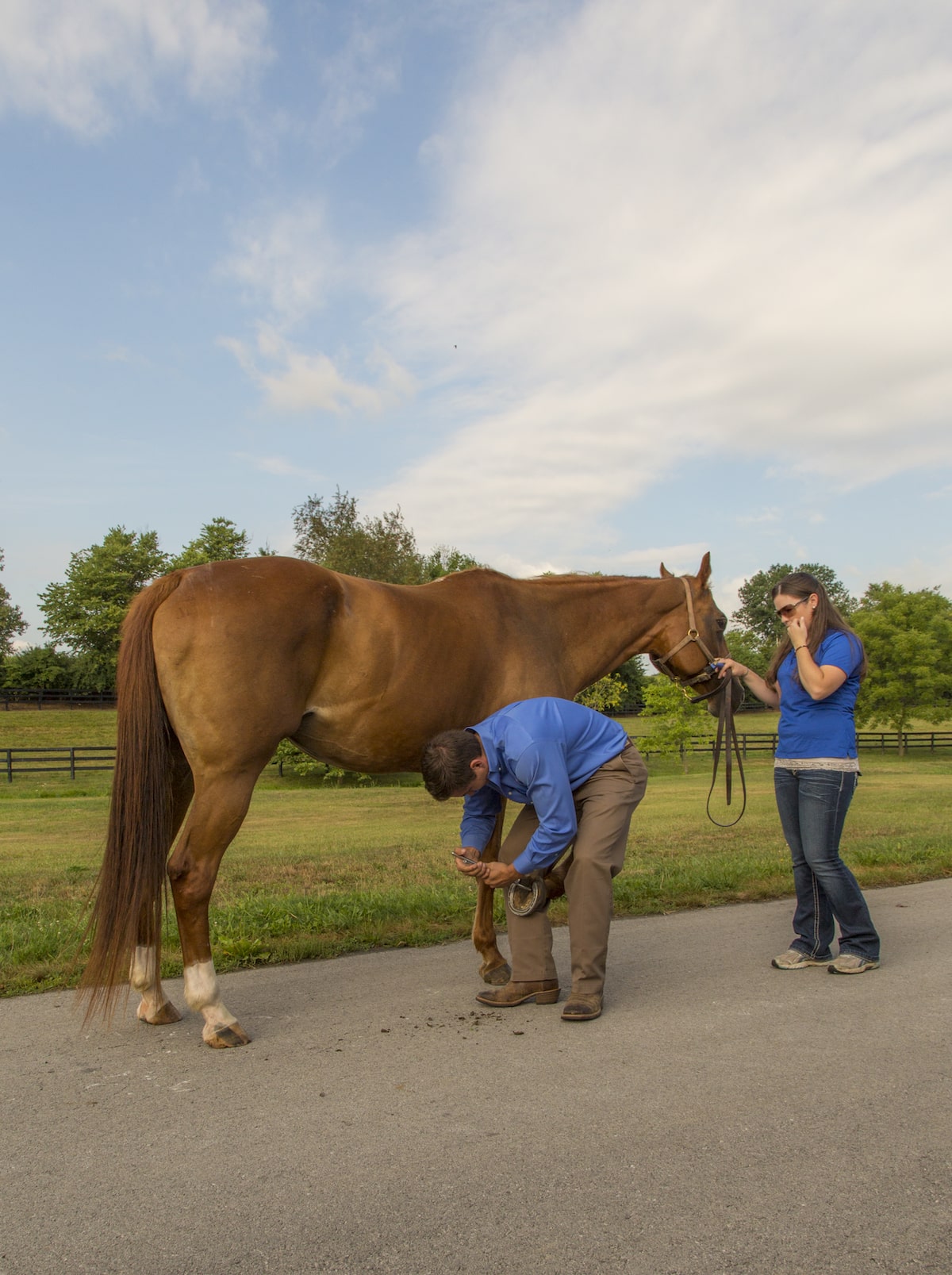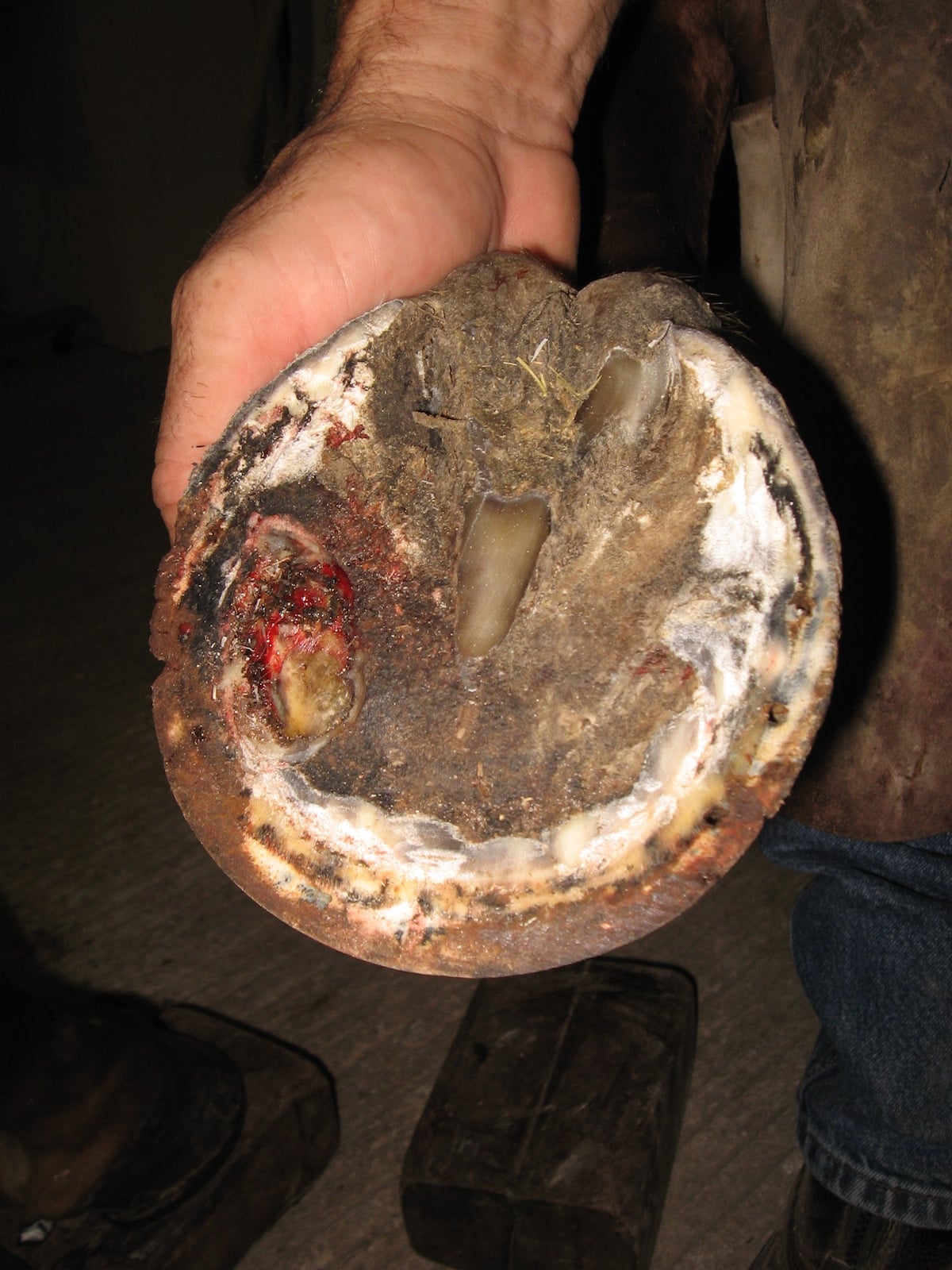A step-by-step guide to managing this frustrating yet treatable hoof infection

A horse with a hoof abscess is lame, has a bounding pulse and has a positive response to hoof testers. Courtesy Kevin Thompson/The Horse
Spring is a welcome and exciting time of year for horse owners and trainers. Warmer, longer days mean more time with our horses. The caveat, however, is the season’s temperate conditions are as favorable to potentially harmful environmental bacteria as they are to humans and horses.
“There is a significant spike in hoof-abscess-related lameness cases between early March and late June,” says Emily Kirkpatrick, DVM, equine and small animal veterinarian and owner of Kinship Animal Hospital, in Richmond, Virginia.
She says many of her patients’ hooves are dry and brittle after winter, rendering them particularly vulnerable to the seasonal surge of microbial growth. Thoroughbreds and Standardbreds tend to be particularly prone to springtime hoof abscesses.
“Many lineages of these breeds have a congenital predisposition for thin-walled hooves, therefore making them especially vulnerable to infection,” Kirkpatrick says.
If you haven’t battled a hoof abscess in your own Thoroughbred, it’s likely only a matter of time. In this article we’ll describe these infections and how to treat them quickly and effectively so you can get back to working your horse.
How Hoof Abscesses Develop
An abscess is an encapsulated accumulation of purulent (pus-containing) material that develops anywhere pathogenic (disease-causing) bacteria have penetrated the body through damaged tissue. If your horse is going to get an abscess, the hoof is an ideal location for it; if infectious material gets inside the hoof, the body detects it immediately, and the immune system responds accordingly by initiating a comprehensive inflammatory response. It deploys white blood cells (known as neutrophils) to the affected area, where they combine with other cellular material to become the fetid substance we know as pus, evidence that an infection is being fought. The resulting product is an abscess.
Reasons hoof abscesses occur include:
■ Injury Microorganisms in the environment are more likely to contaminate the sole or hoof wall if it has sustained a penetrating wound (usually from rocks or sharp debris).
■ Genetics Horses with a congenital predisposition for thin-walled hooves are more susceptible to developing abscess-prone fissures.
■ Climate Cold and arid winter conditions can result in hoof cracks that springtime microbial growth can infiltrate.
■ Disease Keratomas (malignant cancerous tumors of the keratinized hoof wall tissue), laminitis or diseases such as podotrochlosis (navicular syndrome) can create the ideal conditions for abscess development.
Common Signs
The telltale signs of a hoof abscess include:
■ Lameness An affected horse could have a mild hitch in his stride to full-on three-legged lameness, depending on the location of the abscess within the hoof and the severity of the infection.
■ Heat An abscessed hoof and the tissue above it feel significantly warmer to the touch than uninfected tissue.
■ Digital pulse You can feel this in an abscessed hoof by placing your thumb and forefinger on either side of the fetlock joint.
■ Sensitivity Horses with abscesses show a positive response to painful stimuli, such as hoof testers.
Treatment

When an abscess ruptures, you’ll notice an obvious “blowout” site, usually through the hoof’s sole. Courtesy Christy West/The Horse
To get rid of an abscess, you must expel it from within the hoof, most effectively by drawing out the infection using topical expulsion agents. Most farriers no longer recommend the antiquated practice of “digging the infection out” by manually burrowing a tunnel into the hoof because it can result in permanent damage.
Common drawing methods include:
■ Soaking the hoof in a warm, heavily concentrated Epsom salts-water solution. Although generally innocuous and highly effective, this method can “water-log” the hoof, which weakens the wall, so it might not be the best option for horses with thin-walled hooves. This method also requires a certain level of cooperation, so it might not be the most efficient approach for impatient horses.
■ Packing the sole area completely with a drawing ointment such as ichthammol 20%, Animalintex pads or hoof pads pretreated with Epsom salts gel. This method is less labor-intensive than the soak method; however, some drawing agents are safer than others (ichthammol, for instance, contains formaldehyde, which can have a dangerous dehydrating effect on already desiccated hoof wall tissue).
Your veterinarian or farrier should be able to advise you on the most appropriate treatment option for the situation.
The daily abscess medicating and bandaging routine should include the following steps:
1. Prepare the bandage. Tear several strips of duct tape, each one long enough to cross the bottom of the hoof and extend up both sides. Assemble the strips in a lattice pattern large enough to cover the entire hoof. Set it aside, along with a roll of self-adhering bandage (e.g., Vetrap) and any other materials.
2. Prepare the drawing agent. If using the soak method, prepare the bucket of Epsom salts solution. If using the packing method, saturate several gauze squares with your drawing salve of choice. (Pretreated pads are available in commercial “abscess hoof repair kits.”)
3. If using the packing method, thoroughly pick and brush the hoof to remove any mud or debris, and dry it with a towel. The hoof should be clean and dry prior to bandaging.
4. Apply drawing treatment. If soaking, submerge the hoof in warm Epsom salts solution for at least 10 to 15 minutes. Dry it completely prior to bandaging. If using the gauze squares saturated with medication, pack the entire surface of the sole, including the frog and heel, with the drawing salve, and layer with the squares.
5. Apply the bandage. Cover the entire sole and heel area with medicated gauze squares. While not necessary, you can apply an infant-sized swimming diaper over the gauze squares to absorb moisture and cushion the hoof.
Wrap one to two layers of self-adhesive bandage around the hoof, starting at the heel and unraveling the roll diagonally across the bottom of the hoof and up one side of the hoof wall, repeating the pattern until you’ve covered the entire hoof. If the bandage material extends above the hoof, cut several slits along the top to alleviate excess tension along the coronary band.
Place the preprepared duct tape lattice on the bottom of the hoof (adhesive side against the Vetrap) and adhere up the sides of the hoof. Remove any tape that extends beyond 1 or 2 centimeters above the top of the hoof.
You might outfit your horse in a rubber hoof boot to keep the bandage clean and ensure that it stays on.
Repeat the medicating and bandaging process daily until the abscess ruptures. When this happens, you’ll notice an obvious blowout site (ideally through the sole) wherever the abscess has burst, from which it will drain. (Note that sometimes abscesses blow at the coronary band.) Once the abscess has ruptured, you no longer need to bandage or cover the hoof (with the exception of nonpadded rubber boots, so long as the wound has ample exposure to air and drainage is not stifled in any way). Disinfect the wound one to two times daily with a bactericidal, fungicidal and viricidal antiseptic such as povidone-iodine (Betadine), says Kirkpatrick.
After abscess rupture the horse should appear much more comfortable or even completely sound, because the hoof has been relieved of pressure (and subsequent pain). With chronic, long-term or more severe infections, the veterinarian might prescribe an antibiotic topical paste to apply directly to the rupture site.
Take-Home Message
When addressed appropriately, most abscesses resolve completely within two weeks, says Kirkpatrick. However, healing time is unpredictable and depends on the health of horse and hoof, as well as the diligence and quality of medical care. Although no horse is immune to developing hoof abscesses, you can help reduce your OTTB’s risk by:
■ Having an experienced farrier trim and balance his hooves regularly.
■ Feeding a diet rich in calcium and zinc, which help nourish the hoof wall’s keratinized tissue so it’s strong enough to ward off infection.
■ Maintaining as clean and hazard-free an environment as possible to reduce the chances of an abscess-causing injury.
No one thing can prevent your OTTB from developing hoof issues such as abscesses entirely. However, proper attention to nutrition, husbandry and farrier care can help ensure you have a sound horse with which to enjoy the warm, beautiful days of spring.
This article was originally published in the Spring 2020 issue of Off-Track Thoroughbred Magazine, the only publication dedicated to the Thoroughbred ex-racehorse in second careers. Want four information-packed issues a year delivered to your door or your favorite digital device? Subscribe now!

